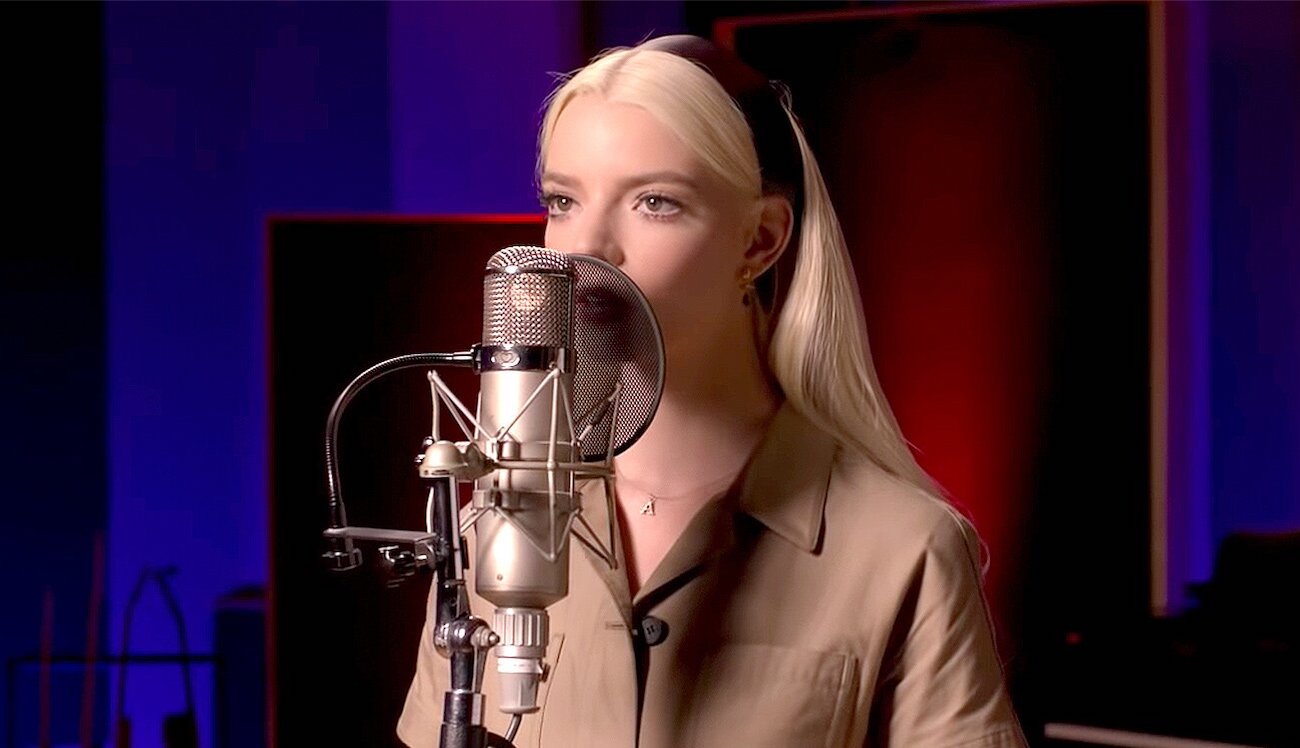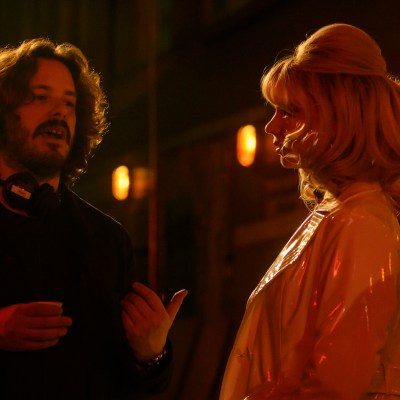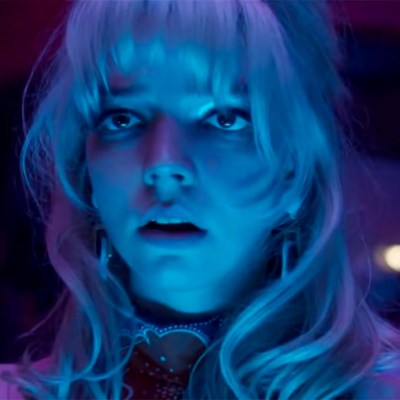Like a needle on a record, Edgar Wright’s Last Night in Soho drops a sharp stylus into a deep groove and lets her spin. Eloise (Thomasin McKenzie) is a modern fashion design student in the film—modern in the sense that she is a 21st century woman living in contemporary England. But in her dreams she is a mid-‘60s Mod, shaking to the sounds of Swinging London. The singer, Sandie (Anya Taylor-Joy), is the most lucid bridge to her subconscious trespass. The soundtrack to the film is the aural equivalent of a middle-eight between the verses and the chorus of time.
The soundtrack seeks to evoke two eras, the sounds of 1965 Soho and present-day London, while keeping time for the film. The movie moves to the rhythm of the background songs, which become a character. The advance single features Taylor-Joy (The Witch) doing a soulful cover of Petula Clark’s classic “Downtown.” It evokes the uneasy wonderland of the ghosts of the past. The soundtrack’s uptempo version, which you can hear on the Spotify playlist below, captures the aura of the memories of the time. The difference between these two recordings, up and downtempo, gets to the heart of the movie itself and perception versus reality. The soundtrack also includes an a capella version of the song, which is as haunting as the film.
The different versions also tell another story, how the song evolves internally for Sandie from audition to performance, all while still evoking the sonic textures of the movie. The tracks were produced by the film’s composer, Steven Brice, who scored both Baby Driver and The World’s End. Leading an orchestra recording at the famed Abbey Road Studios in London, the sessions are done accurately to the period.
Taylor-Joy also recorded a version of Cilla Black’s “You’re My World” for the soundtrack, providing an earthier contrast to the actual Black standard, which we hear sung by an impersonator at the Café de Paris in the film. “You’re My World” was originally recorded in 1963 as “Il mio mondo” by Umberto Bindi, who co-wrote it with Gino Paoli. George Martin, best known as the Beatles’ producer, commissioned an English version for Black, his protégé at the time. Vocal group the Breakaways sing background vocals. Judd Proctor is the lead guitarist, Kenny Clare is the drummer. It would be Black’s second chart topper. In 1977 Helen Reddy’s version of “You’re My World” broke the Top 20 in the U.S. Ritchie Blackmore of Deep Purple and Rainbow, plays guitar on it.
Born Priscilla Maria Veronica White in the Vauxhall district of Liverpool, the singer was known as Cilla Black because of a misprint in local music magazine, Mersey Beat. She worked part-time as a cloakroom attendant at the Cavern Club (as Sandie marvels in Last Night in Soho), and the Beatles were early boosters. She was backed by Merseybeat bands the Big Three, Rory Storm and the Hurricanes, and Kingsize Taylor and the Dominoes.
John Lennon introduced Black to Brian Epstein, the Beatles manager, and the Beatles backed her for an audition. It didn’t go well, because Black was nervous and didn’t specify her preferred key, but ultimately George Martin signed her to Parlophone Records. Her third single, “You’re My World,” hit No. 1 on the British charts on May 30, 1964 and stayed there for four weeks, a week longer than her previous single “Anyone Who Had a Heart.” Written by Burt Bacharach and Hal David for Dionne Warwick in 1963, it was her first Top 10 hit in the U.S., but Cilla’s cover ruled Britannia’s charts. Tim Curry recorded a cover of the song for his 1978 debut album Read My Lips.
“Anyone Who Had a Heart” was the first song to use polyrhythm in pop music, changing time signature from 4/4 to 5/4, with a bar of 7/8 bar in the close. This is something the Beatles are known for effortlessly executing. Black’s debut single, “Love of the Loved,” was written by Lennon and Paul McCartney. Black would go on to record “Yesterday,” “For No One,” “Across the Universe,” and “The Long and Winding Road,” which McCartney called the definitive version. The opening song in the film, Peter and Gordon’s “A World Without Love,” where McKenzie’s Ellie dreamily dances around her bedroom, is also credited to Lennon; McCartney.
“A World Without Love” was the first single for the British duo Peter and Gordon, released in February 1964. It was written by McCartney when he was 16. In 1963, the bass-playing songwriter was sharing a room in the house of his girlfriend, actress Jane Asher, along with her brother Peter who’d been signed to a recording contract with his partner Gordon Waller. Although the song is co-credited to Lennon, in interviews Lennon has said Paul had the whole song before the Beatles, and personally appreciated the opening line, “Please lock me away,” as very funny. McCartney didn’t think the song was good enough for the Beatles, but it is one of only two Lennon; McCartney songs to reach No. 1 in the U.S. by an artist other than the Beatles. The other is Elton John’s 1974 cover of “Lucy in the Sky with Diamonds,” which has Lennon on rhythm guitar.
In the film, Sandie Shaw’s “Puppet on a String” is playing when Taylor-Joy’s Sandie books what at first looked like a prime Cabaret gig, but Ellie realizes there are major strings attached. Not only that, the strings would probably cover more than the corset Sandie is required to wear. If that’s not on-the-nose enough, the amply endowed singer she is backing is costumed as a marionette. “Puppet on a String” was written by Bill Martin and Phil Coulter. Sung by Shaw, it was the first UK entry to win the Eurovision Song Contest held in Vienna in 1967.
The lucky song was Shaw’s 13th thirteenth UK single, and her third No. 1 hit on the UK Singles Charts. Shaw was no fan of the tune, however, hating it “from the very first ‘oompah’ to the final ‘bang’ on the big bass drum. I was instinctively repelled by its sexist drivel and cuckoo-clock tune,” she said in her 1991 autobiography The World at My Feet: A Personal Adventure. The film and soundtrack also includes Shaw’s “(There’s) Always Something There to Remind Me.” Written by Bacharach and David, it was originally recorded as a demo by Dionne Warwick in 1963. Shaw’s cover was rush-released in September 1964, and sold 65,000 copies in a week after she performed it on Ready Steady Go! Naked Eyes’ 1983 reinterpretation also hit the Top 10.
1968’s Barry Ryan with the Majority hit, “Eloise,” may be the song Ellie is named after, although it could merely have been someone who looks just like her. “Eloise” was written by Paul Ryan and sung by his twin brother Barry Ryan. Clocking in at more than five minutes, it was a long song for a single. The tune was influenced by the dramatic arrangement of Richard Harris’ rendition of Jimmy Webb’s “MacArthur Park.” “Eloise” was recorded in two takes at IBC Studios, and the session musicians included future Led Zeppelin players Jimmy Page and John Paul Jones.
The title of the film itself comes from a song of the same name by Dave Dee, Dozy, Beaky, Mick & Tich. “Last Night in Soho” was written by the band’s Ken Howard and Alan Blaikley, and was the outfit’s final top-ten hit. “Why did they lead me astray? For last night in Soho I let my life go,” the lyrics sing. Scratchy guitar fills riff over a tease of music’s evil diminished 5th tritone chord progression in this leather-boy motorbike rocker. “I never told you of some things I’ve done I’m so ashamed of.” Yes, Soho was chic. It was hip and cool, fab and gear, and all those other pimply hyperboles, but the West End of London was also renowned as the center of the city’s sex trade and gang turf.
Of course, the biggest gangs of London during the mid-1960s were the modernist Mods in their Union Jack shirts, and the greasy, leather-clad Rockers. Uppers and downers, blues, bennies, and goofballs, blood flowed any way for the Mods, who rode Vespa scooters and kept their hair cut neat. Their image crystallized by the band the Who. Their rendition of “Heat Wave,” included in Last Night in Soho, is an excellent example of what separated the two rival youth factions.
Read more
Rockers liked old-style, three-chord, rock and roll, the kind Elvis, Eddie Cochran and Gene Vincent used to play. “Heat Wave” is an amped-up version of a soul track by the Motown vocal group Martha and the Vandellas. It is a song so magical, the chord progression alone inspired John Sebastian’s propulsive opening to The Lovin’ Spoonful’s “Do You Believe in Magic.” Written in 1963 by the Holland–Dozier–Holland songwriting team, “Heat Wave” packs a gospel backbeat, jazz horn phrasings, and call-and-response backing vocals into a sensual mix for dancing or grinding, fucking of fighting. Things get crazy in the heat.
At the time the Who—which was composed of singer Roger Daltrey, guitarist Pete Townshend, bass guitarist John Entwistle, and drummer Keith Moon—was known for smashing instruments on stage. It started out as an accident but came to encapsulate what Townshend called “My Generation.” To be fair though, Moon broke a bass drum pedal and tore a drum skin when he auditioned for the band. But songwriters Entwistle and Townshend also pushed the soft horror and mild kink, with songs like “Boris the Spider,” and “I’m a Boy,” about a “head case” named Bill, whose mother won’t admit he’s not a girl.
But both Eloise and Sandie are girls, and each in their own way are “Starstruck,” which is The Kinks’ contribution to the soundtrack. The song comes from the band’s sixth studio album, The Kinks Are the Village Green Preservation Society (1968) and explores how people get absorbed by their culture and are led astray. It was the last album recorded by original members Ray Davies, Dave Davies, Pete Quaife, and Mick Avory.
“Everybody’s got their own village green, somewhere you go to when the world gets too much,” Ray Davies said in interviews about the album. Ray suffered mental exhaustion, and the album warns “Dreams often fade and die in a bad, bad world.” On “Starstruck,” Ray could be singing to either Sandie or Ellie in Last Night of Soho. “You’re a victim of bright city lights and your mind is not right.”
“Land of 1000 Dances” by the Walker Brothers is a good analogy for the dreamscape Eloise escapes to—and Sandie gets lost in, as the tune takes on a nightmarish quality during her descent into nightclub hell.
The original song includes 16 dances: the Pony, the Chicken, the Mashed Potato, the Alligator, the Watusi, the Twist, the Fly, the Jerk, the Tango, the Yo-Yo, the Sweet Pea, the Hand jive, the Slop, the Bop, the Fish, and the Popeye. The song was written and first recorded by Chris Kenner in 1962. Other versions were done by Cannibal & the Headhunters, Wilson Pickett, and Patti Smith.
“I’ve Got My Mind Set on You” was written by Rudy Clark and recorded by James Ray in 1962. George Harrison released a cover version in 1987. It was the ex-Beatle guitarist’s last No. 1 in the U.S. The soundtrack also includes “Wade in the Water” by the Graham Bond Organisation; “There’s a Ghost in My House,” by R. Dean Taylor; and “Happy House” by Siouxsie & the Banshees.
Beyond that, the instrumental incidental music, and “Neon,” by Steven Price, which is on the soundtrack release, present the sonic surround of the era’s film music. We hear echoes of Ennio Morricone and musique concréte as the inner-dialogue collides with the aural presentation. Last Night in Soho may well be a modern ghost story classic, but the soundtrack will always be a haunting reminder.
Last Night in Soho is in theaters now.


